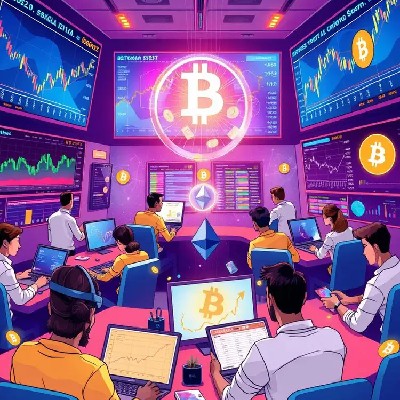Bitget: ¡En el Top 4 por volumen de trading diario global!
Cuota de mercado de BTC61.27%
Nuevos listados en Bitget : Pi Network
BTC/USDT$82621.69 (+0.02%)Índice de miedo y codicia32(Miedo)
Índice de la temporada de altcoins:0(Temporada de Bitcoin)
Monedas listadas en el pre-mercadoPAWS,WCTFlujo neto total de ETF en spot de Bitcoin -$93.2M (1d); +$445.2M (7d). Paquete de obsequios de bienvenida para nuevos usuarios por valor de 6.200 USDT.Reclamar ahora
Tradea en cualquier momento y lugar con la app de Bitget. Descargar ahora
Bitget: ¡En el Top 4 por volumen de trading diario global!
Cuota de mercado de BTC61.27%
Nuevos listados en Bitget : Pi Network
BTC/USDT$82621.69 (+0.02%)Índice de miedo y codicia32(Miedo)
Índice de la temporada de altcoins:0(Temporada de Bitcoin)
Monedas listadas en el pre-mercadoPAWS,WCTFlujo neto total de ETF en spot de Bitcoin -$93.2M (1d); +$445.2M (7d). Paquete de obsequios de bienvenida para nuevos usuarios por valor de 6.200 USDT.Reclamar ahora
Tradea en cualquier momento y lugar con la app de Bitget. Descargar ahora
Bitget: ¡En el Top 4 por volumen de trading diario global!
Cuota de mercado de BTC61.27%
Nuevos listados en Bitget : Pi Network
BTC/USDT$82621.69 (+0.02%)Índice de miedo y codicia32(Miedo)
Índice de la temporada de altcoins:0(Temporada de Bitcoin)
Monedas listadas en el pre-mercadoPAWS,WCTFlujo neto total de ETF en spot de Bitcoin -$93.2M (1d); +$445.2M (7d). Paquete de obsequios de bienvenida para nuevos usuarios por valor de 6.200 USDT.Reclamar ahora
Tradea en cualquier momento y lugar con la app de Bitget. Descargar ahora

Relacionado con la moneda
Calculadora de precios
Historial de precios
Predicción de precios
Análisis técnico
Guía de compra de la moneda
Categoría cripto
Calculadora de ganancias
Relacionado con el trading
Comprar/vender
Depositar/retirar
Spot
Margen
Futuros USDT-M
Futuros Coin-M
Bots de trading
Copy trading
Earn
Pre-mercado
Actualizaciones de la moneda
Noticias de The Infinite Garden
Alerta de The Infinite Garden
Calendario de eventos
ICO
Airdrop

Precio de The Infinite GardenETH
No listado
Moneda de cotización:
EUR
Los datos proceden de proveedores externos. Esta página y la información proporcionada no respaldan ninguna criptomoneda específica. ¿Quieres tradear monedas listadas? Haz clic aquí
€0.004084+2.12%1D
Gráfico de precios
Última actualización el 2025-03-30 21:14:20(UTC+0)
Capitalización de mercado:--
Capitalización de mercado totalmente diluida:--
Volumen (24h):--
Volumen en 24h/Capitalización de mercado:0.00%
Máximo 24h:€0.003893
Mínimo 24h:€0.003629
Máximo histórico:€0.2459
Mínimo histórico:€0.0009188
Suministro circulante:-- ETH
Suministro total:
10,000,000ETH
Tasa de circulación:0.00%
Suministro máx.:
10,000,000ETH
Precio en BTC:0.{7}5383 BTC
Precio en ETH:1 ETH
Precio en la capitalización de mercado de BTC:
--
Precio en la capitalización de mercado de ETH:
--
Contratos:
0x5e21...378d613(Ethereum)
Más
¿Qué opinas hoy de The Infinite Garden?
Nota: Esta información es solo de referencia.
Precio actual de The Infinite Garden
El precio de The Infinite Garden en tiempo real es de €0.004084 por (ETH / EUR) hoy con una capitalización de mercado actual de €0.00 EUR. El volumen de trading de 24 horas es de €0.00 EUR. ETH a EUR el precio se actualiza en tiempo real. The Infinite Garden es del 2.12% en las últimas 24 horas. Tiene un suministro circulante de 0 .
¿Cuál es el precio más alto de ETH?
ETH tiene un máximo histórico (ATH) de €0.2459, registrado el 2024-03-13.
¿Cuál es el precio más bajo de ETH?
ETH tiene un mínimo histórico (ATL) de €0.0009188, registrado el 2024-01-14.
Predicción de precios de The Infinite Garden
¿Cuál será el precio de ETH en 2026?
Según el modelo de predicción del rendimiento histórico del precio de ETH, se prevé que el precio de ETH alcance los €0.004365 en 2026.
¿Cuál será el precio de ETH en 2031?
En 2031, se espera que el precio de ETH aumente en un +16.00%. Al final de 2031, se prevé que el precio de ETH alcance los €0.01194, con un ROI acumulado de +159.83%.
Historial del precio de The Infinite Garden (EUR)
El precio de The Infinite Garden fluctuó un -96.97% en el último año. El precio más alto de en EUR en el último año fue de €0.1930 y el precio más bajo de en EUR en el último año fue de €0.002447.
FechaCambio en el precio (%) Precio más bajo
Precio más bajo Precio más alto
Precio más alto 
 Precio más bajo
Precio más bajo Precio más alto
Precio más alto 
24h+2.12%€0.003629€0.003893
7d-15.57%€0.003422€0.004345
30d+47.08%€0.002447€0.01514
90d-27.50%€0.002447€0.01514
1y-96.97%€0.002447€0.1930
Histórico-95.31%€0.0009188(2024-01-14, 1 año(s) atrás )€0.2459(2024-03-13, 1 año(s) atrás )
Información del mercado de The Infinite Garden
Capitalización de mercado de The Infinite Garden
Capitalización de mercado
--
Capitalización de mercado totalmente diluida
€40,842.5
Clasificación de mercado
Holdings de The Infinite Garden
Matriz de distribución de holdings de The Infinite Garden
Holdings por concentración de The Infinite Garden
Ballenas
Inversores
Minoristas
The Infinite Garden direcciones por tiempo en holding
Holders
Cruisers
Traders
Gráfico de precios de coinInfo.name (12) en tiempo real

Clasificación de The Infinite Garden
Clasificaciones promedio de la comunidad
5
Este contenido solo tiene fines informativos.
ETH a la moneda local
1 ETH a MXN$0.091 ETH a GTQQ0.031 ETH a CLP$4.131 ETH a UGXSh16.11 ETH a HNLL0.111 ETH a ZARR0.081 ETH a TNDد.ت0.011 ETH a IQDع.د5.821 ETH a TWDNT$0.151 ETH a RSDдин.0.481 ETH a DOP$0.281 ETH a MYRRM0.021 ETH a GEL₾0.011 ETH a UYU$0.191 ETH a MADد.م.0.041 ETH a OMRر.ع.01 ETH a AZN₼0.011 ETH a KESSh0.571 ETH a SEKkr0.041 ETH a UAH₴0.18
- 1
- 2
- 3
- 4
- 5
Última actualización el 2025-03-30 21:14:20(UTC+0)
Noticias de The Infinite Garden

Los ETF de Bitcoin y Ethereum muestran tendencias contrastantes en los flujos de capital
Coinedition•2025-03-30 17:44
Nuevos listados en Bitget
Nuevos listados
Comprar más
Preguntas frecuentes
¿Cuál es el precio actual de The Infinite Garden?
El precio en tiempo real de The Infinite Garden es €0 por (ETH/EUR) con una capitalización de mercado actual de €0 EUR. El valor de The Infinite Garden sufre fluctuaciones frecuentes debido a la actividad continua 24/7 en el mercado cripto. El precio actual de The Infinite Garden en tiempo real y sus datos históricos están disponibles en Bitget.
¿Cuál es el volumen de trading de 24 horas de The Infinite Garden?
En las últimas 24 horas, el volumen de trading de The Infinite Garden es de €0.00.
¿Cuál es el máximo histórico de The Infinite Garden?
El máximo histórico de The Infinite Garden es €0.2459. Este máximo histórico es el precio más alto de The Infinite Garden desde su lanzamiento.
¿Puedo comprar The Infinite Garden en Bitget?
Sí, The Infinite Garden está disponible actualmente en el exchange centralizado de Bitget. Para obtener instrucciones más detalladas, consulta nuestra útil guía Cómo comprar .
¿Puedo obtener un ingreso estable invirtiendo en The Infinite Garden?
Desde luego, Bitget ofrece un plataforma de trading estratégico, con bots de trading inteligentes para automatizar tus trades y obtener ganancias.
¿Dónde puedo comprar The Infinite Garden con la comisión más baja?
Nos complace anunciar que plataforma de trading estratégico ahora está disponible en el exchange de Bitget. Bitget ofrece comisiones de trading y profundidad líderes en la industria para garantizar inversiones rentables para los traders.
¿Dónde puedo comprar cripto?
Sección de video: verificación rápida, trading rápido

Cómo completar la verificación de identidad en Bitget y protegerte del fraude
1. Inicia sesión en tu cuenta de Bitget.
2. Si eres nuevo en Bitget, mira nuestro tutorial sobre cómo crear una cuenta.
3. Pasa el cursor por encima del ícono de tu perfil, haz clic en "No verificado" y haz clic en "Verificar".
4. Elige tu país o región emisora y el tipo de ID, y sigue las instrucciones.
5. Selecciona "Verificación por teléfono" o "PC" según tus preferencias.
6. Ingresa tus datos, envía una copia de tu ID y tómate una selfie.
7. Envía tu solicitud, ¡y listo! Habrás completado la verificación de identidad.
Las inversiones en criptomoneda, lo que incluye la compra de The Infinite Garden en línea a través de Bitget, están sujetas al riesgo de mercado. Bitget te ofrece formas fáciles y convenientes de comprar The Infinite Garden, y hacemos todo lo posible por informar exhaustivamente a nuestros usuarios sobre cada criptomoneda que ofrecemos en el exchange. No obstante, no somos responsables de los resultados que puedan surgir de tu compra de The Infinite Garden. Ni esta página ni ninguna parte de la información que incluye deben considerarse respaldos de ninguna criptomoneda en particular.
Bitget Insights

Crypto_inside
4h
Doge coin ❌ Shiba inu. 💥😳
Dogecoin (DOGE) and Shiba Inu (SHIB) are two popular cryptocurrencies that originated as meme-based tokens but have since gained significant attention and market value.
Similarities:
1. Meme-based origins: Both DOGE and SHIB originated as meme-based tokens, with DOGE featuring the "Doge" Shiba Inu meme and SHIB featuring a similar Shiba Inu character.
2. Community-driven: Both cryptocurrencies have strong community support, with active user bases and dedicated followers.
3. Decentralized: Both DOGE and SHIB are decentralized cryptocurrencies, meaning that there is no central authority controlling them.
Differences:
1. Blockchain: DOGE is based on the Litecoin blockchain, while SHIB is an ERC-20 token built on the Ethereum blockchain.
2. Supply: DOGE has a total supply of 132.67 billion coins, while SHIB has a total supply of 1 quadrillion (1,000,000,000,000,000) tokens.
3. Use cases: DOGE is primarily used for peer-to-peer transactions and charitable donations, while SHIB is focused on building a decentralized ecosystem with various use cases, such as NFTs and DeFi applications.
4. Market capitalization: DOGE has a larger market capitalization than SHIB, with a market cap of around $25.31 billion compared to SHIB's market cap of around $7.47 billion.
Investment and Trading Considerations:
1. Volatility: Both DOGE and SHIB are highly volatile cryptocurrencies, with prices subject to rapid fluctuations.
2. Market sentiment: The prices of both cryptocurrencies are heavily influenced by market sentiment and community enthusiasm.
3. Adoption and use cases: The success of both cryptocurrencies will depend on their ability to develop and promote practical use cases and achieve widespread adoption.
In conclusion, while both DOGE and SHIB have their unique characteristics and features, they share a common meme-based origin and community-driven spirit. As with any investment or trading decision, it's essential to conduct thorough research and consider multiple factors before making a decision.
Thank you...🙂
$SHIB $DOGE $BTC $ETH $XRP $PI $BGB $ADA $SUNDOG $NEIROETH $DOGS $BCH $QTUM $COQ $AI $PONKE $PEPE $MEME
SUNDOG+2.05%
BTC-0.03%
BGUSER-6R9PPRUG
4h
$ IMT
In the world of cryptocurrency, market sentiment is one of the most important factors influencing the price action of any digital asset. Bearish sentiment, characterized by a general outlook of pessimism, can significantly impact a token's price. For $IMT , the prevailing bearish sentiment can be a signal of a potential market correction or downward price trend. This could be influenced by a variety of factors, including broader market conditions, technical indicators, or external developments that shift investor sentiment toward caution or fear.
In this deep dive, we'll explore the reasons behind the bearish sentiment surrounding $IMT and examine whether market corrections will impact its price. We will also look at how such sentiment can affect both short-term and long-term price movements and what traders and investors should watch out for.
1. What is Bearish Sentiment?
Bearish sentiment refers to a general feeling of pessimism in the market, where investors expect the price of an asset to fall. In the context of $IMT, bearish sentiment means that traders and investors expect the price of the token to decline due to a range of factors. This sentiment often leads to more selling than buying, as investors look to exit positions before prices fall further.
When bearish sentiment takes hold, the following factors can come into play:
Declining demand: Fewer investors are willing to buy the token at higher prices.
Increased selling pressure: More holders might want to liquidate their positions in anticipation of a decline.
Market fear and panic: Negative news, poor performance, or general uncertainty can cause panic selling, driving prices even lower.
2. Reasons Behind Bearish Sentiment in $IMT
There are several reasons why bearish sentiment might take hold for $IMT:
a) Broader Market Conditions
Global Economic Conditions: Like all cryptocurrencies, $IMT is susceptible to macroeconomic factors. If there is a global economic downturn, such as a recession, inflation fears, or rising interest rates, investors may pull back from riskier assets like cryptocurrencies. During periods of economic uncertainty, many investors opt for safe-haven assets such as gold or the US dollar, causing digital assets like $IMT to face downward pressure.
Crypto Market-Wide Bearish Trends: Sometimes, bearish sentiment around a specific cryptocurrency is driven by larger trends within the entire crypto market. If major cryptocurrencies like Bitcoin (BTC) or Ethereum (ETH) are experiencing a downturn, the effect tends to ripple across smaller altcoins, including $IMT. A general market correction can trigger a broad sell-off, leading to a decline in the value of $IMT as investors turn risk-averse.
b) Regulatory Concerns
The cryptocurrency market is still relatively young and under the scrutiny of regulators across the world. If there is negative news regarding regulatory crackdowns or governments introducing stringent regulations against cryptocurrencies, this can lead to panic and a rush to liquidate positions.
For $IMT, if its project faces regulatory hurdles or if it operates in a jurisdiction where crypto regulations are becoming more restrictive, this could create negative sentiment. Regulatory uncertainty can erode investor confidence and trigger a bearish trend in the token's price.
c) Weak Market Fundamentals
Project Development Delays: If $IMT fails to deliver on promised upgrades, integrations, or key partnerships, it can cause investors to lose confidence in the long-term potential of the project. A lack of updates or technical glitches might signal that the project is stagnating, which can trigger sell-offs.
Lack of Utility or Adoption: $IMT may face a scenario where its use case is questioned, or its adoption rate is slower than expected. Without clear utility or growing demand for the token, the market may begin to see $IMT as an underperforming asset, leading to a decrease in demand and ultimately price decline.
d) Whale Manipulation and Market Sentiment
Whales are large investors or entities that hold substantial amounts of $IMT. If a whale starts selling off large amounts of the token, it can trigger panic among smaller investors, leading to more selling. This sell-off by a few large holders can contribute to a cascading effect, where others follow suit and cause a significant price drop.
Negative sentiment can also be influenced by social media discussions or news outlets, which can exacerbate panic selling, further fueling the bearish trend.
e) Technical Indicators Signaling Weakness
Resistance Levels: If $IMT faces rejection at key resistance levels (a price point at which the token struggles to move past), this could signal the inability of buyers to push the price higher. This type of price action could create a technical bearish scenario, where traders expect the price to fall back to lower support levels.
Bearish Divergence in RSI: The Relative Strength Index (RSI) is a key momentum indicator. A bearish divergence occurs when the price of $IMT is making higher highs, but the RSI is making lower highs. This indicates that while the price is increasing, the momentum behind it is weakening, signaling potential for a reversal to the downside.
Death Cross: A Death Cross occurs when the short-term moving average (such as the 50-day MA) crosses below the long-term moving average (such as the 200-day MA). This technical pattern is often seen as a bearish signal, suggesting that the market sentiment is turning negative, which could lead to further price declines for $IMT.
3. The Impact of Market Corrections on $IMT's Price
A market correction refers to a temporary decline in the price of an asset (typically around 10% or more from its recent highs). For $IMT, a correction can occur due to a combination of factors, including broader market sell-offs, technical factors, and shifts in investor sentiment.
a) Short-Term Impact: Price Declines and Increased Volatility
Increased Volatility: During market corrections, prices often experience high volatility. For $IMT, this means that while its price could dip sharply in the short term, it may also experience large price swings as buyers look for buying opportunities during the dip, and sellers attempt to exit positions.
Fear and Panic: In the short term, bearish sentiment can trigger panic selling, causing $IMT’s price to rapidly fall. This can create a negative feedback loop, where declining prices cause further panic, leading to additional selling and further price declines.
b) Long-Term Impact: Resetting Expectations
Recalibrating Valuations: A market correction often serves as a period of price consolidation, where overvalued assets are brought back to more sustainable levels. If $IMT has been in an overbought condition, a correction could be beneficial by helping to reset unrealistic price expectations. Once this price correction occurs, $IMT might establish a more solid foundation for future growth.
Accumulation Opportunities: Corrections also provide a chance for long-term investors to accumulate tokens at a lower price. If $IMT has a strong use case and technological foundation, investors might view a correction as an opportunity to buy the dip and hold for future potential.
4. Indicators to Watch for Signs of a Bearish Trend
If bearish sentiment continues, there are several key indicators to watch for that will confirm a sustained downtrend or continued market correction for $IMT:
Breaking Support Levels: If $IMT breaks below important support levels, it could confirm a bearish trend. Watch for the price to close below key technical levels such as the 50-day or 200-day moving average or significant horizontal support.
Decreasing Volume: During a bearish trend, volume often declines, signaling that the buying interest has faded and that fewer participants are willing to enter at current price levels.
Increased Selling Pressure: A rise in selling volume or large sell-offs by whales can indicate that sentiment is shifting towards the negative, potentially leading to further price declines.
5. How Traders Can Respond to Bearish Sentiment
a) Risk Management Strategies
Stop-Loss Orders: To manage risk during a bearish trend, traders may want to implement stop-loss orders to automatically sell their $IMT holdings at a predetermined price, protecting them from further declines.
Hedging Positions: Traders can also hedge against bearish price movements by using options or futures contracts to take short positions on $IMT or use other assets as a hedge.
b) Waiting for Market Stabilization
In the event of a market correction, some traders prefer to wait until the market stabilizes before re-entering positions. A period of price consolidation can help determine if $IMT has found a new equilibrium price and is ready for a recovery.
Conclusion: Will Market Corrections Impact $IMT’s Price?
Bearish sentiment and market corrections can have a profound impact on the price of $IMT. If the broader market continues to show signs of weakness, $IMT may experience significant downward pressure, exacerbated by declining market confidence and technical indicators signaling a reversal. However, market corrections are also natural phases in asset price cycles and can present opportunities for long-term investors to acquire tokens at lower prices.
For traders and investors, it’s essential to carefully monitor technical signals, market sentiment, and broader economic factors to assess whether the bearish trend is short-lived or indicative of more prolonged price decline.
$IMT
BTC-0.03%
MOVE-4.20%

Mi$h_£va💸
4h
$ IMT
In the world of cryptocurrency, market sentiment is one of the most important factors influencing the price action of any digital asset. Bearish sentiment, characterized by a general outlook of pessimism, can significantly impact a token's price. For $IMT , the prevailing bearish sentiment can be a signal of a potential market correction or downward price trend. This could be influenced by a variety of factors, including broader market conditions, technical indicators, or external developments that shift investor sentiment toward caution or fear.
In this deep dive, we'll explore the reasons behind the bearish sentiment surrounding $IMT and examine whether market corrections will impact its price. We will also look at how such sentiment can affect both short-term and long-term price movements and what traders and investors should watch out for.
1. What is Bearish Sentiment?
Bearish sentiment refers to a general feeling of pessimism in the market, where investors expect the price of an asset to fall. In the context of $IMT, bearish sentiment means that traders and investors expect the price of the token to decline due to a range of factors. This sentiment often leads to more selling than buying, as investors look to exit positions before prices fall further.
When bearish sentiment takes hold, the following factors can come into play:
Declining demand: Fewer investors are willing to buy the token at higher prices.
Increased selling pressure: More holders might want to liquidate their positions in anticipation of a decline.
Market fear and panic: Negative news, poor performance, or general uncertainty can cause panic selling, driving prices even lower.
2. Reasons Behind Bearish Sentiment in $IMT
There are several reasons why bearish sentiment might take hold for $IMT:
a) Broader Market Conditions
Global Economic Conditions: Like all cryptocurrencies, $IMT is susceptible to macroeconomic factors. If there is a global economic downturn, such as a recession, inflation fears, or rising interest rates, investors may pull back from riskier assets like cryptocurrencies. During periods of economic uncertainty, many investors opt for safe-haven assets such as gold or the US dollar, causing digital assets like $IMT to face downward pressure.
Crypto Market-Wide Bearish Trends: Sometimes, bearish sentiment around a specific cryptocurrency is driven by larger trends within the entire crypto market. If major cryptocurrencies like Bitcoin (BTC) or Ethereum (ETH) are experiencing a downturn, the effect tends to ripple across smaller altcoins, including $IMT. A general market correction can trigger a broad sell-off, leading to a decline in the value of $IMT as investors turn risk-averse.
b) Regulatory Concerns
The cryptocurrency market is still relatively young and under the scrutiny of regulators across the world. If there is negative news regarding regulatory crackdowns or governments introducing stringent regulations against cryptocurrencies, this can lead to panic and a rush to liquidate positions.
For $IMT, if its project faces regulatory hurdles or if it operates in a jurisdiction where crypto regulations are becoming more restrictive, this could create negative sentiment. Regulatory uncertainty can erode investor confidence and trigger a bearish trend in the token's price.
c) Weak Market Fundamentals
Project Development Delays: If $IMT fails to deliver on promised upgrades, integrations, or key partnerships, it can cause investors to lose confidence in the long-term potential of the project. A lack of updates or technical glitches might signal that the project is stagnating, which can trigger sell-offs.
Lack of Utility or Adoption: $IMT may face a scenario where its use case is questioned, or its adoption rate is slower than expected. Without clear utility or growing demand for the token, the market may begin to see $IMT as an underperforming asset, leading to a decrease in demand and ultimately price decline.
d) Whale Manipulation and Market Sentiment
Whales are large investors or entities that hold substantial amounts of $IMT. If a whale starts selling off large amounts of the token, it can trigger panic among smaller investors, leading to more selling. This sell-off by a few large holders can contribute to a cascading effect, where others follow suit and cause a significant price drop.
Negative sentiment can also be influenced by social media discussions or news outlets, which can exacerbate panic selling, further fueling the bearish trend.
e) Technical Indicators Signaling Weakness
Resistance Levels: If $IMT faces rejection at key resistance levels (a price point at which the token struggles to move past), this could signal the inability of buyers to push the price higher. This type of price action could create a technical bearish scenario, where traders expect the price to fall back to lower support levels.
Bearish Divergence in RSI: The Relative Strength Index (RSI) is a key momentum indicator. A bearish divergence occurs when the price of $IMT is making higher highs, but the RSI is making lower highs. This indicates that while the price is increasing, the momentum behind it is weakening, signaling potential for a reversal to the downside.
Death Cross: A Death Cross occurs when the short-term moving average (such as the 50-day MA) crosses below the long-term moving average (such as the 200-day MA). This technical pattern is often seen as a bearish signal, suggesting that the market sentiment is turning negative, which could lead to further price declines for $IMT.
3. The Impact of Market Corrections on $IMT's Price
A market correction refers to a temporary decline in the price of an asset (typically around 10% or more from its recent highs). For $IMT, a correction can occur due to a combination of factors, including broader market sell-offs, technical factors, and shifts in investor sentiment.
a) Short-Term Impact: Price Declines and Increased Volatility
Increased Volatility: During market corrections, prices often experience high volatility. For $IMT, this means that while its price could dip sharply in the short term, it may also experience large price swings as buyers look for buying opportunities during the dip, and sellers attempt to exit positions.
Fear and Panic: In the short term, bearish sentiment can trigger panic selling, causing $IMT’s price to rapidly fall. This can create a negative feedback loop, where declining prices cause further panic, leading to additional selling and further price declines.
b) Long-Term Impact: Resetting Expectations
Recalibrating Valuations: A market correction often serves as a period of price consolidation, where overvalued assets are brought back to more sustainable levels. If $IMT has been in an overbought condition, a correction could be beneficial by helping to reset unrealistic price expectations. Once this price correction occurs, $IMT might establish a more solid foundation for future growth.
Accumulation Opportunities: Corrections also provide a chance for long-term investors to accumulate tokens at a lower price. If $IMT has a strong use case and technological foundation, investors might view a correction as an opportunity to buy the dip and hold for future potential.
4. Indicators to Watch for Signs of a Bearish Trend
If bearish sentiment continues, there are several key indicators to watch for that will confirm a sustained downtrend or continued market correction for $IMT:
Breaking Support Levels: If $IMT breaks below important support levels, it could confirm a bearish trend. Watch for the price to close below key technical levels such as the 50-day or 200-day moving average or significant horizontal support.
Decreasing Volume: During a bearish trend, volume often declines, signaling that the buying interest has faded and that fewer participants are willing to enter at current price levels.
Increased Selling Pressure: A rise in selling volume or large sell-offs by whales can indicate that sentiment is shifting towards the negative, potentially leading to further price declines.
5. How Traders Can Respond to Bearish Sentiment
a) Risk Management Strategies
Stop-Loss Orders: To manage risk during a bearish trend, traders may want to implement stop-loss orders to automatically sell their $IMT holdings at a predetermined price, protecting them from further declines.
Hedging Positions: Traders can also hedge against bearish price movements by using options or futures contracts to take short positions on $IMT or use other assets as a hedge.
b) Waiting for Market Stabilization
In the event of a market correction, some traders prefer to wait until the market stabilizes before re-entering positions. A period of price consolidation can help determine if $IMT has found a new equilibrium price and is ready for a recovery.
Conclusion: Will Market Corrections Impact $IMT’s Price?
Bearish sentiment and market corrections can have a profound impact on the price of $IMT. If the broader market continues to show signs of weakness, $IMT may experience significant downward pressure, exacerbated by declining market confidence and technical indicators signaling a reversal. However, market corrections are also natural phases in asset price cycles and can present opportunities for long-term investors to acquire tokens at lower prices.
For traders and investors, it’s essential to carefully monitor technical signals, market sentiment, and broader economic factors to assess whether the bearish trend is short-lived or indicative of more prolonged price decline.
$IMT
BTC-0.03%
MOVE-4.20%

Crypto_inside
4h
Etherium Blocks ❌ Solana Blocks. 💥😳
Ethereum and Solana are two popular blockchain platforms that enable the creation of decentralized applications (dApps). Here's a comparison of their block structures:
Ethereum Blocks:
1. Block Time: Ethereum blocks are generated every 15 seconds on average.
2. Block Size: Ethereum blocks have a variable size, but the maximum size is around 8 million gas units.
3. Transactions: Ethereum blocks can contain multiple transactions, including smart contract executions and token transfers.
4. Gas Mechanism: Ethereum uses a gas mechanism to measure the computational effort required to execute transactions and smart contracts.
5. Block Reward: Ethereum's block reward is currently set at 2 ETH per block, plus transaction fees.
Solana Blocks:
1. Block Time: Solana blocks are generated every 400 milliseconds on average.
2. Block Size: Solana blocks have a variable size, but the maximum size is around 128 MB.
3. Transactions: Solana blocks can contain multiple transactions, including smart contract executions and token transfers.
4. Proof of History (PoH): Solana uses a proof-of-stake (PoS) consensus algorithm called Proof of History (PoH), which allows for faster block times and higher scalability.
5. Block Reward: Solana's block reward is currently set at 1.5 SOL per block, plus transaction fees.
Key Differences:
1. Block Time: Solana blocks are generated much faster than Ethereum blocks.
2. Block Size: Solana blocks can be larger than Ethereum blocks.
3. Scalability: Solana's PoH consensus algorithm allows for higher scalability than Ethereum's proof-of-work (PoW) consensus algorithm.
4. Gas Mechanism: Ethereum uses a gas mechanism, while Solana does not.
Thank you...🙂
$BTC $ETH $SOL $PI $ADA $BGB $XRP $ETC $AI $DOGS $SUNDOG $LTC $BCH $CATS $SHIB
SUNDOG+2.05%
BTC-0.03%

BGUSER-TZP8DU8P
4h
Trading the $PARTI /USDT Pair: A Complete Guide
Cryptocurrency trading continues to attract traders looking for new opportunities to profit from market fluctuations. One such trading pair is $PARTI /USDT, where $PARTI represents a digital asset, and USDT (Tether) serves as the stablecoin for trading. This guide will help you understand how to trade this pair effectively, including market analysis, strategies, and risk management.
---
1. Understanding the $PARTI /USDT Trading Pair
What is $PARTI ?
$PARTI is a cryptocurrency that traders buy or sell against USDT.
It may be associated with a blockchain project, decentralized platform, or utility token.
Before trading, research its fundamentals, including its use case, market cap, and recent news.
What is USDT?
USDT (Tether) is a stablecoin pegged to the U.S. dollar, offering price stability.
Trading against USDT eliminates volatility associated with trading against BTC or ETH.
---
2. Choosing the Right Exchange
To trade $PARTI /USDT, you need a crypto exchange that supports this pair. Consider:
Liquidity: High liquidity ensures smooth execution of trades.
Security: Choose a platform with a strong security track record.
Trading Fees: Compare fees across exchanges to minimize costs.
Trading Tools: Look for advanced features like stop-loss orders, margin trading, and charting tools.
Popular exchanges such as Binance, KuCoin, Gate.io, or Bybit might list this pair depending on availability.
---
3. Market Analysis and Trading Strategies
Successful trading depends on solid market analysis. Here are key approaches:
A. Technical Analysis
Charting tools help analyze price movements and predict trends. Key indicators include:
Moving Averages (MA) – Identifies trend direction (e.g., 50-day and 200-day MA).
Relative Strength Index (RSI) – Determines whether the asset is overbought or oversold.
MACD (Moving Average Convergence Divergence) – Identifies trend reversals.
Support & Resistance Levels – Helps identify key price levels for buy/sell decisions.
B. Fundamental Analysis
Project News – Any updates regarding $PARTI can impact price movements.
Partnerships and Developments – New collaborations or technological upgrades can increase demand.
Market Sentiment – Social media discussions, crypto forums, and overall market trends affect price action.
C. Trading Strategies
1. Scalping – Profiting from small price movements within minutes or hours.
2. Day Trading – Buying and selling within a single trading day.
3. Swing Trading – Holding for days or weeks based on market trends.
4. Long-Term Holding – Investing based on the long-term potential of $PARTI .
---
4. Risk Management in $PARTI /USDT Trading
Risk management is crucial for consistent profits. Follow these tips:
Set Stop-Loss Orders – Prevents major losses during market downturns.
Diversify Investments – Avoid putting all funds into one asset.
Use Proper Position Sizing – Trade with only a portion of your portfolio.
Stay Updated – Follow crypto news and price alerts to react to market changes.
---
5. Executing a Trade on $PARTI /USDT
Steps to Place a Trade
1. Deposit USDT into your exchange wallet.
2. Find the $PARTI /USDT pair on the exchange.
3. Analyze the Market using technical and fundamental strategies.
4. Select an Order Type:
Market Order – Executes instantly at the current price.
Limit Order – Executes at a specific price you set.
Stop-Loss Order – Protects against potential losses.
5. Monitor Your Trade and adjust strategies accordingly.
---
6. Final Thoughts
Trading $PARTI /USDT can be a profitable venture if approached with the right strategy and risk management. Whether you are a beginner or an experienced trader, it is essential to stay informed about market trends, use effective analysis tools, and trade responsibly.
BTC-0.03%
ETH-0.39%
Activos relacionados
Criptomonedas populares
Una selección de las 8 criptomonedas principales por capitalización de mercado.
Agregada recientemente
Las criptomonedas agregadas más recientemente.
Capitalización de mercado comparable
Entre todos los activos de Bitget, estos 8 son los más cercanos a The Infinite Garden en capitalización de mercado.



































